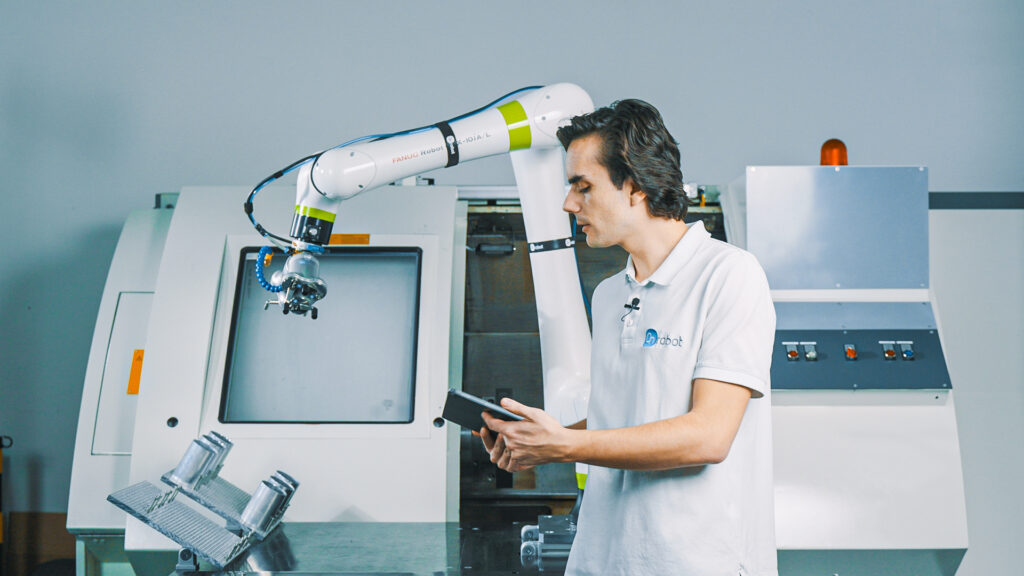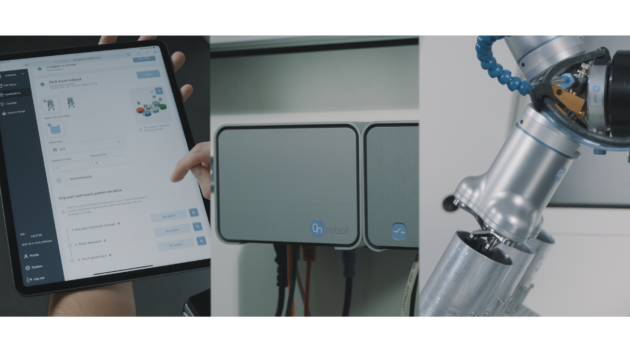
Tech talk: It’s the end of robot programming!
January 15, 2024
By Kristian Hulgard
The ‘no-programming’ approach democratizes collaborative automation and simplifies robot integration.
 The ‘no-programming’ method simplifies the process of deploying collaborative automation on CNC machines by eliminating hours of repetitive, manual programming tasks. (Photo: OnRobot)
The ‘no-programming’ method simplifies the process of deploying collaborative automation on CNC machines by eliminating hours of repetitive, manual programming tasks. (Photo: OnRobot) Industrial robot programming has evolved massively since the days of punch tape and paper-based flowcharts. Teach pendants existed back in the 70s, but they were clunky affairs, intimidating to non-experts, and not exactly user-friendly.
The 1980s brought usability improvements as pendant makers incorporated digital displays and more intuitive interfaces. At the same time, the rise of computer-based programming led to the emergence of all sorts of robot programming software, more user-friendly interfaces, offline programming, and CAD integration. Expert engineers were still required for the vast majority of industrial robot programming tasks, however.
And yet, despite incremental improvements in usability accumulating over time, robot programming methods stayed more or less the same until the emergence of collaborative robots (cobots) and lightweight industrial robot arms in the 2000s.
Fulfilling the promise of collaborative automation
Collaborative automation is the fastest-growing segment of the industrial robot market. Cobot-based systems are attractive to companies of all sizes thanks to their affordability, fast ROI, small footprint, and ability to switch between different products and applications.
Designed to break down barriers to automation adoption, particularly among small to medium size businesses (SMEs), these lightweight, collaborative industrial robots enable easy hand-guiding and ship with intuitive teaching pendants.
Recently, so-called ‘low- and no-code programming’ approaches have come to market. These systems use visual modelling and drag-and-drop user interfaces. Low-/no-code programming is an advancement, but unless the application is very simple, some programming knowledge is still required to ensure a safe and successful deployment.
Do you have ‘no-programming’ experience?
Today, another leap in usability has been achieved – the elimination of programming altogether.
And not only do I feel fine about that, I think it’s a massively positive development; a fulfilment of the democratizing premise of collaborative automation, which promises to deliver robots that can be deployed easily, regardless of the end user’s previous robotics experience, or lack thereof.
The elimination of robot programming liberates both end-users and robotics integrators, slashes deployment times, and improves return on investment (ROI).
Combined with the growing trend towards open, plug-and-play hardware, these new, ‘programming-free’ approaches also help to address the labour and skills shortages being experienced by both manufacturing companies and robotics integrators. This enables both manufacturers and robot integrators to boost their business despite labour shortages, thereby supporting automation adoption globally.
Time-consuming traditions
Deploying traditional industrial robots is a costly and time-consuming process that requires robotics engineers with in-depth knowledge of numerous robot systems and programming languages. This complexity has pushed traditional industrial automation beyond the budgets and competencies of SMEs.
Collaborative automation, to varying degrees, breaks down this complexity, via a range of usability features that enable people with little or no previous robotics experience to deploy automation quickly, safely and effectively.
For example, many cobot brands provide hand-guiding features designed to speed up the deployment process. Instead of wasting time in pendant-based programming, cobot users can program the system by guiding the robot and end-effector into position by hand and setting various points along the way.
While collaborative automation has proven fast and easy to deploy for straightforward processes, many end users have found that their ideal application is actually more sophisticated than they assumed.
Moreover, reprogramming and redeployment for new products or to add productivity improvements has proven challenging for many SMEs, requiring the expertise of an integrator. For SMEs with high-mix, low-volume production requirements, the complexity remains sufficiently high to put them off a robotics investment altogether.

Automated deployment platforms remove the need for manual work for integrators by automating program logic, signals exchange, event handling and robot motion planning. (Photo: OnRobot)
Decades in the making
User-friendly interfaces and programming techniques reduce deployment lead times and costs, benefitting end-users and integrators alike. But the culmination of all of these trends and advancements in usability is fully automated deployment and programming. This decades-old industry goal has been achieved.
Programming-free deployments liberate integrators from a wide range of tedious manual programming processes, making collaborative industrial automation deployments faster and easier than ever before. This new technology automates the process of building, running, monitoring, and redeploying collaborative automation. The result is complete applications that can be deployed and redeployed directly on the manufacturing floor in a few simple steps, with zero programming required.
The time savings are impossible to ignore. For example, deployment of a collaborative palletizing application using traditional methods will typically take an integrator around 40 hours to complete. Using the new, programming-free approach, the entire deployment takes around four hours – a massive 90 percent time savings.
Or consider a collaborative CNC machine tending application that typically takes 36 hours to set up, program, test and deploy using traditional deployment approaches.
Robotic machine tending deployment requires expertise at each step. This begins with choosing the robot and its mounting to fit into existing shop floor layouts and to work with defined infeed and outfeed setups. Next, single or dual grippers must be sourced, and these must meet workpiece size, weight, and type requirements. Decisions have to be made on how best to mount the tool to meet the application’s needs. Should you use an end-effector quick changer to enable fast and easy change-overs for handling different work pieces?
Additionally, CNC machine integration requires an understanding of the machine’s capabilities and communications so that actions such as door opening and closing and starting machine cycles can be automated. Meanwhile, multi-step applications add additional complexities such as defining realignment or regrip steps, and cleaning steps before or after processing. No wonder setup typically takes at least 36 hours.
By contrast, using the automated ‘no programming’ system, that same application deployment takes approximately six hours. This minimizes time and cost by enabling end users and integrators to get the system up and running for faster returns. The platform automatically discovers most of the installed hardware and configures the interfaces to provide immediate control over them. Meanwhile, workspace obstacles are defined using a single simple interface. The platform automatically generates an optimized, collision-free path for the robot arm. The platform also automatically generates all the program logic, signals exchange, events handling, and path planning of the robot for the entire application – based on just a few inputs.
How to eliminate programming
This new approach to automation deployments is built on software that abstracts the programming details required for successful deployment such as path planning, program logic, signals exchange and event handling. All that complex robotics know-how is built into the system.
All the user has to do is define the cell boundaries and obstacles and from there the software automatically produces an optimized program for that specific application, whether it’s machine tending or palletizing.
Once the automated setup is complete, users just click a button to run the application. They can also monitor application performance in real-time to boost productivity and minimize downtime. All of this means that complete applications can be quickly deployed on the factory floor and that ongoing changes can be managed in-house even by operators with zero prior robotics experience.
Many collaborative automation companies have always aspired to empower SMEs with technology. It’s all part of a collective industry aim to democratize robotics by breaking down barriers around complexity and cost. By eliminating programming, collaborative automation has taken a giant step towards those goals. In the process, manufacturers and end users are liberated from tedious manual programming tasks forever – and they feel fine.
 Kristian Hulgard is general manager of the Americas division at OnRobot. He has been part of the collaborative robot market since its emergence and is a thought leader in cobot applications and activation of robots in the collaborative space.
Kristian Hulgard is general manager of the Americas division at OnRobot. He has been part of the collaborative robot market since its emergence and is a thought leader in cobot applications and activation of robots in the collaborative space.
Advertisement
- ABB expands robotics portfolio with acquisition of Swiss start-up Sevensense
- Kitchener-based FluidAI Medical’s $25M investment receives provincial support